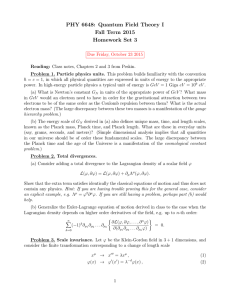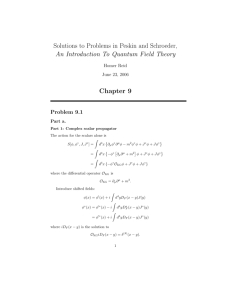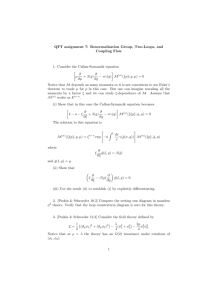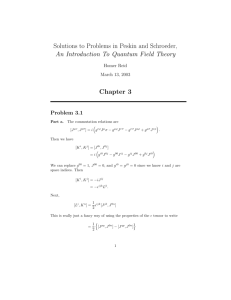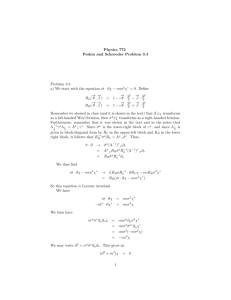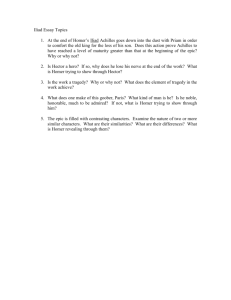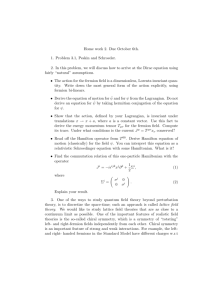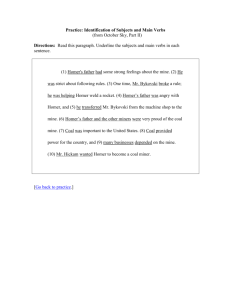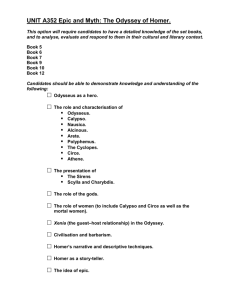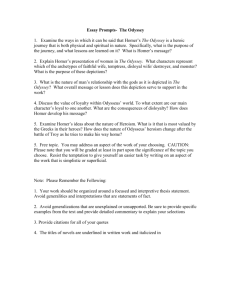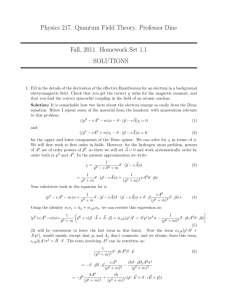Solutions to Problems in Peskin and Schroeder, An
advertisement
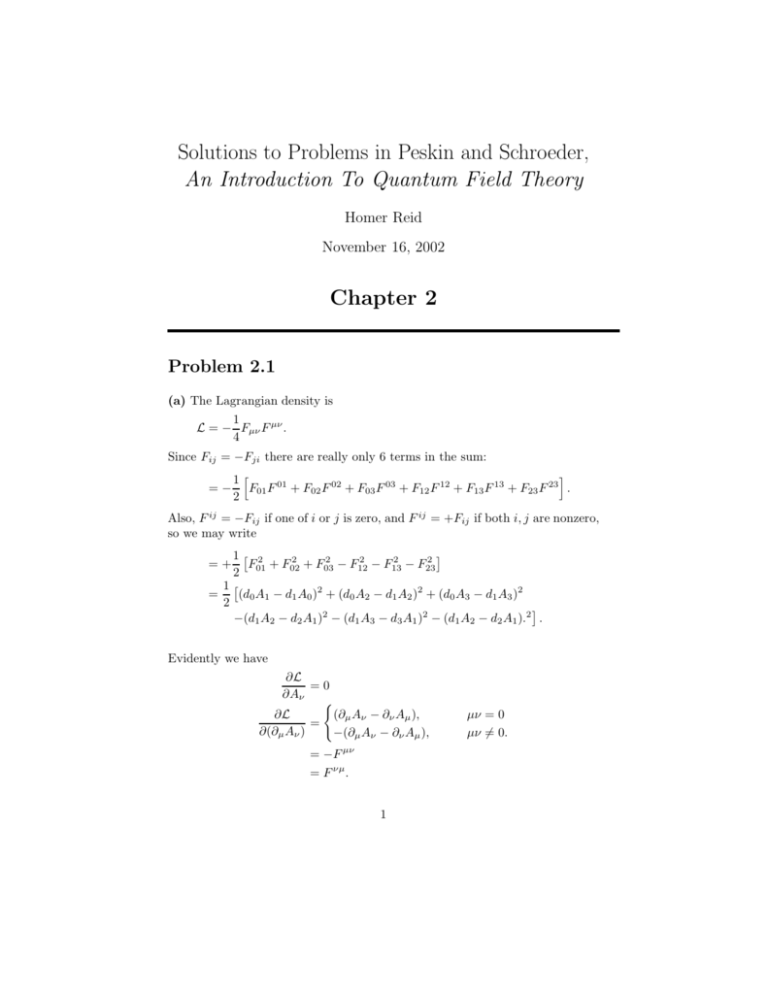
Solutions to Problems in Peskin and Schroeder, An Introduction To Quantum Field Theory Homer Reid November 16, 2002 Chapter 2 Problem 2.1 (a) The Lagrangian density is 1 L = − Fµν F µν . 4 Since Fij = −Fji there are really only 6 terms in the sum: i 1h = − F01 F 01 + F02 F 02 + F03 F 03 + F12 F 12 + F13 F 13 + F23 F 23 . 2 Also, F ij = −Fij if one of i or j is zero, and F ij = +Fij if both i, j are nonzero, so we may write 1 2 2 2 2 2 2 F + F02 + F03 − F12 − F13 − F23 2 01 1 = (d0 A1 − d1 A0 )2 + (d0 A2 − d1 A2 )2 + (d0 A3 − d1 A3 )2 2 −(d1 A2 − d2 A1 )2 − (d1 A3 − d3 A1 )2 − (d1 A2 − d2 A1 ).2 . =+ Evidently we have ∂L =0 ∂Aν ( (∂µ Aν − ∂ν Aµ ), ∂L = ∂(∂µ Aν ) −(∂µ Aν − ∂ν Aµ ), = −F µν = F νµ . 1 µν = 0 µν 6= 0. Homer Reid’s Solutions to Peskin and Schroeder Problems: Chapter 2 2 Hence the Euler-Lagrange equation is 0 = ∂µ ∂L ∂(∂µ Aν ) = ∂µ F νµ = ∂µ ∂ ν Aµ − ∂µ ∂ µ Aν . Identifying E i = −F 0i and B k = −ijk F ij , the Euler-Lagrange equations become that ∂1 E 1 + ∂2 E 2 + ∂3 E 3 = 0 ijk ∂i Bj = ∂0 Ek (∇ · E = 0) ∂E . ∇×B= ∂t which are two of Maxwell’s equations. (b) First let’s review this whole Noether theorem business. Suppose we make a change, parameterized by a small parameter α, under which the fields in the Lagrangian undergo the transformations φi (x) → φ0i (x) = φi (x) + α∆φi (x) (1) where the ∆φi (x) are fields themselves. This transformation does not affect the equations of motion if the Lagrangian of the system is only modified by the addition of the divergence of a four-vector, i.e. if L → L0 = L + α∂µ J µ (x). (2) On the other hand, computing directly from (1) we can also write the transformed Lagrange density as X ∂L ∂L (α∆φi ) + (α∂µ ∆φi ) L → L0 = L + ∂φi ∂(∂µ φi ) i X ∂L ∂L ∂L =L+α (∆φi ) + ∂µ ∆φi − ∆φi ∂µ ∂φi ∂(∂µ φi ) ∂(∂µ φi ) i (where we used the chain rule, ∂(f g) = f ∂g + g∂f ) X ∂L ∂L ∂L =L+α ∂µ ∆φi + ∆φi − ∂µ ∂(∂µ φi ) ∂φi ∂(∂µ φi ) i X ∂L = L + α∂µ ∆φi ∂(∂µ φi ) i where we used the Euler-Lagrange equation in going to the last line. Comparing with (2) we see that ∂µ X i ∂L ∆φi = ∂µ J µ ∂(∂µ φi ) Homer Reid’s Solutions to Peskin and Schroeder Problems: Chapter 2 3 or ∂µ j µ = 0, jµ = J µ − X ∆φi i ∂L . ∂(∂µ φi ) In the specific case of space-time translations, the symmetry in question is xµ → xµ + aµ . We consider only translations in one dimension, so that only the ρth component of aµ is nonzero, and we put aµ = ax̂ρ . The Lagrangian transforms according to L → L0 = L + a∂ρ L To rewrite this in the form of (2), we define the vector J by setting its ρth component equal to L and the rest of its components to zero: = L + a∂µ J µ , J µ = Lδ µρ . On the other hand, the components of the fields themselves transform according to Aµ (x) → A0µ (x) = Aµ (x) + a∂ρ Aµ (x) so in this case ∆φµ = ∂ρ Aµ , µ = 0, 1, 2, 3. Then the conserved current corresponding to translations in the xρ direction is X ∂L ∂ρ Aµ jν = J ν − ∂(∂ A ) ν µ µ = Lδ νρ − F µν ∂ρ Aµ = Lδ νρ − F µν ∂ ρ Aµ ≡ T νρ (3) This is evidently not symmetric in the ν and ρ indices. Instead we consider T̂ νρ = T νρ − ∂λ (F νλ Aρ ) = T νρ − Aρ (∂λ F νλ ) − F νλ (∂λ Aρ ) The vanishing of the middle term here is the Euler-Lagrange equation we worked out in part one, so we just get = T νρ − F νλ (∂λ Aρ ) Substituting back in from equation (3) we find = Lδρν − F λν (∂ ρ Aλ ) − F νλ (∂λ Aρ ) = Lδρν − F λν (∂ ρ Aλ − ∂λ Aρ ) = Lδ νρ − F λν F ρλ = Lδ νρ + F νλ F ρλ which is symmetric in the ν and ρ indices. 4 Homer Reid’s Solutions to Peskin and Schroeder Problems: Chapter 2 Problem 2.2 The complex scalar field. Part a. The momentum conjugate to φ is ∂L ∂(∂t φ) ∂ = (∂t φ∗ )(∂t φ) − (∇φ∗ ) · (∇φ) + m2 φ∗ φ ∂(∂t φ) = ∂t φ∗ . π= Similarly, the momentum conjugate to φ∗ is π ∗ = ∂t φ. Then the canonical commutation relations are [φ, ∂t φ∗ ] = [φ∗ , ∂t φ] = i. The Hamiltonian density is H = π(∂t φ) + π ∗ (∂t φ∗ ) − L = (∂t φ)(∂t φ∗ ) + (∂t φ∗ )(∂t φ) − (∂t φ)(∂t φ∗ ) + (∇φ) · (∇φ∗ ) + m2 φ∗ φ = (∂t φ)(∂t φ∗ ) + (∇φ) · (∇φ∗ ) + m2 φ∗ φ (4) Expressed in terms of the variables appropriate for the Hamiltonian description, we have = ππ ∗ + (∇φ) · (∇φ∗ ) + m2 φ∗ φ. (5) The equation of motion for φ is i ∂ φ(xµ ) = [H, φ(xµ )] ∂t Z = = H(x ) d x , φ(x ) 0µ Z 3 0 µ d3 x0 [H(x0µ ), φ(xµ )] The only term in (5) that fails to commute with φ is the term containing π: Z = d3 x [π(x0µ ), φ(xµ )]π ∗ (x0µ ) Z = i d3 x δ(x0 − x)π ∗ (x0µ ) = iπ ∗ (xµ ). Before computing the a little: Z H= Z = (6) equation of motion for π ∗ we rewrite the Hamiltonian H d3 x h i π ∗ π + (∇φ∗ ) · (∇φ) + m2 φ∗ φ d3 x Homer Reid’s Solutions to Peskin and Schroeder Problems: Chapter 2 5 Integrating by parts on the middle term and expecting that the surface term vanishes since the fields vanish at infinity (but how does this work since the fields are operators and not numbers?) we obtain = Z h i π ∗ π + φ∗ (−∇2 + m2 )φ d3 x. Commuting this with π ∗ , we obtain Z ∂ ∗ µ i π (x ) = −i δ(x − x0 ) (−∇2 + m2 )φ(x0µ ) d3 x0µ ∂t = −i(−∇2 + m2 )φ(xµ ). Combining this with (6) we obtain 2 − m2 φ = 0, i.e. the Klein-Gordon equation. Part b. Since φ is no longer purely real, the coefficient of eip·x in its Fourier expansion no longer need equal the adjoint of the coefficient of e−ip·x . We put Z µ µ d3 p p φ(x, t) = (ap e−ipµ x + b†p eipµ x ) 3 (2π) 2ωp Z µ µ d3 p p (a†p eipµ x + bp e−ipµ x ) φ∗ (x, t) = (2π)3 2ωp Then we have π = ∂t φ∗ (x, t) = i Z d3 p (2π)3 r µ ωp † ipµ xµ (ap e − bp e−ipµ x ) 2 and [φ(xµ ), π(y µ )] = −i Z d3 p d3 p0 2 · (2π)6 = iδ(x − y) r o µ 0 µ 0 µ ω p0 n [ap , a†p0 ]e−i(pµ x −pµ xµ ) − [b†p , bp0 ]e−i(pµ x −pµ y ) ωp where we have assumed [ap , a†p0 ] = [bp , b†p0 ] = δ(p − p0 ) and all other commutators vanish. So there are two different particles of mass m, one created by a† and one created by b† . Homer Reid’s Solutions to Peskin and Schroeder Problems: Chapter 2 6 Part c. The symmetry in this case is with respect to the global phase of φ. We can take φ → eiα φ ≈ (1 + iα)φ without affecting the dynamics. The corresponding conserved Noether current is given by jµ = J µ − X i ∂L ∆φi . ∂(∂µ φi ) Under this symmetry operation the Lagrangian doesn’t change at all, so J µ = 0. The generators of changes in the fields are ∆φ = iφ and ∆φ∗ = −iφ∗ , while ∂L/∂(∂µ φ) = ∂ µ φ∗ and vice versa. Then we obtain j µ = i(φ∂ µ φ − φ∗ ∂ µ φ). Integrating the 0 component of this, we obtain the conserved charge: Z Q = i d3 x (φπ ∗ − φ∗ π). The flipped sign and extra factor of 2 as compared with the expression in P+S are obviously just matters of convention. Expressed in terms of creation and destruction operators, we have Z Z Z 3 3 3 0n µ 0 µ µ 0 µ d xd pd p ap a†p0 eix (pµ −p ) − ap bp0 e−ix (pµ +p ) Q=i 6 2(2π) o µ 0 µ µ 0 µ b†p a†p0 eix (pµ +p ) − b†p bp0 e−ix (pµ −p ) − c.c. The integral over x cancels a factor of (2π)3 and gives us some δ functions: = i 2 Z Z d3 p d3 p0 n ap a†p0 δ(p0 − p) − ap bp0 δ(p0 + p) (2π)3 o b†p a†p0 δ(p0 + p) − b†p bp0 δ(p0 − p) − c.c. Z o i d3 p n † † † † = − c.c. a a − a b + b a − b b p p −p p p p −p p 2 (2π)3 Z d3 p † = ap ap − b†p bp . 3 (2π) So the a and b particles have the opposite sign of the charge. Part d. Working in full generality from the start, we imagine we have n complex scalar fields, whose real and imaginary parts we assemble into a column vector of 2n real fields: φ1r (x) φ1i (x) Φ = φ2r (x) . .. . φni (x) Homer Reid’s Solutions to Peskin and Schroeder Problems: Chapter 2 7 The Lagrangian is L= Xh ∂µ φ∗n ∂ µ φn − m2 φ∗n φn n = (∂µ Φ)t (∂ µ Φ) − m2 Φt Φ i Since the fields all have the same mass, we can arbitrarily redefine which fields we call which without affecting the Lagrangian dynamics. In fact, the Lagrangian remains invariant under any morphing of the fields into linear combinations of themselves, so long as the “length” of the vector Φ remains constant. All transformations that satisfy this condition can be represented by multiplying Φ by a matrix M ∈ SO(2n), i.e. Φ → Φ0 = M Φ. Now, any matrix M ∈ SO(2n) may be written M = ei(α1 J 1 +α2 J 2 +···+αm J m ) where the αi are arbitrary real parameters and the J i are matrices containing exactly two nonzero entries, a +1 in one of the upper diagonal entries and a -1 in the transposed entry. Since there are 2n(2n − 1)/2 upper diagonal slots in a 2n × 2n matrix, there are m = 2n(2n − 1)/2 generator matrices J i for SO(2n). For example, for n = 2 we have 0 0 0 0 0 1 0 0 1 0 0 0 0 0 0 0 0 0 −1 0 0 0 3 2 1 J = J = J = 0 0 0 −1 0 0 0 0 0 0 0 −1 0 0 0 0 0 0 0 0 0 0 0 0 0 0 0 0 0 0 0 0 0 0 0 0 0 0 0 1 0 0 1 0 J6 = J5 = J4 = 0 0 0 0 0 0 0 0 −1 0 0 0 0 −1 0 −1 0 0 0 0 0 0 Hence the internal symmetry group of the Lagrangian for n complex scalar fields is a 2n(2n − 1)/2-parameter group, and there are thus 2n(2n − 1)/2 conserved currents. For example, for 2 complex scalar fields there are 4 · 3/2 = 6 conserved currents. To find the conserved current associated with the kth parameter, we consider the transformation k Φ → eiαJ Φ ≈ (1 + iαJ k )Φ. The Lagrangian is unchanged under this transformation, so again J µ = 0. The generator of transformations in the mth field (where m = 1, 2, · · · , 2n counts separately over the real and imaginary components of the n complex fields) is X k ∆φm = i Jmp φp p = i J kΦ m 1 0 0 0 0 0 . 1 0 Homer Reid’s Solutions to Peskin and Schroeder Problems: Chapter 2 8 (Note that the k superscript on J selects which of the matrices we’re talking about, while the m, p subscripts select which entry of that matrix we want). On the other hand, as before, ∂L/∂(∂µ φm ) = ∂ µ φ∗m Hence the conserved Noether current corresponding to the kth parameter in the parameterization of SO(2n) is jkµ = − X m ∂L ∆φm ∂(∂µ φm ) X X k (∂ µ φ∗m ) Jmp φp = −i m p ! We could also write this as = −i X . (∂ µ φ∗m ) J k Φ m m The conserved charge density corresponding to the kth parameter is the 0 component of this four-vector: X πm J k Φ ρk = −i m t k m = −iΠ J Φ. where the ith entry of the column vector Π is the canonical momentum conjugate to the ith field in the column vector Φ. Problem 2.3 Since the integral is Lorentz invariant we can choose any convenient reference frame in which to work, and we choose the frame in which q µ ≡ (xµ − y µ ) has the form q µ = (0, rk). Then the dot product between the vectors is pµ qµ = p0 q 0 − p · q = −pr r cos θ. Then in polar coordinates the integral is Z ∞ Z π Z 2π 1 p2 dp ipr r cos θ p D(x − y) = D(q) = dθ e sin θ dφ (2π)3 0 2 p2 + m2 0 0 Z ∞ Z 1 p2 dp 1 p du eipr ru = (2π)2 0 2 p2 + m2 −1 Homer Reid’s Solutions to Peskin and Schroeder Problems: Chapter 2 9 (where we did the φ integral and put u = cos θ in the θ integral) = 1 2π 2 r Z ∞ 0 p sin pr dp p . p 2 + m2 Now, Gradstein and Ryzhik equation (3.754.2) is Z ∞ cos ax dx p = K0 (aβ). β 2 + x2 0 Differentiating both sides with respect to a, we obtain Z ∞ a sin ax dx p − = −βK00 (aβ) = βK1 (aβ). β 2 + x2 0 Comparing with (7) we find D(x − y) = m 1 K1 (m|x − y|). 2π 2 |x − y| (7)

